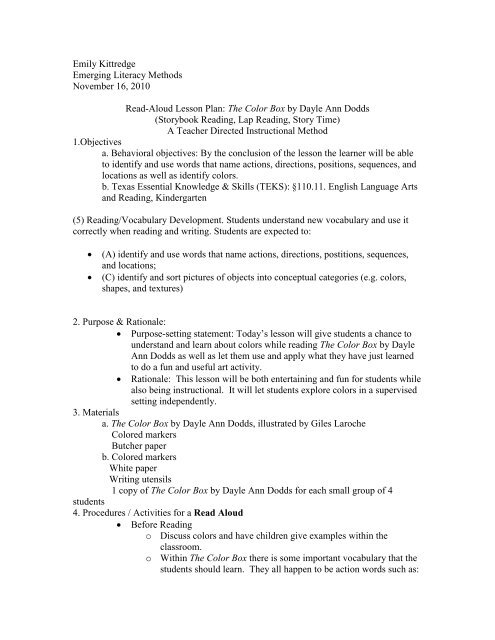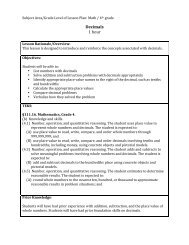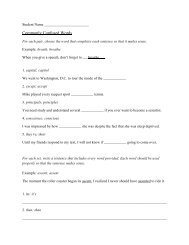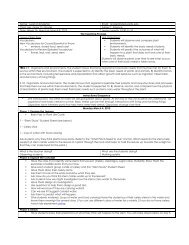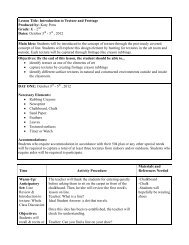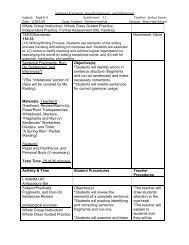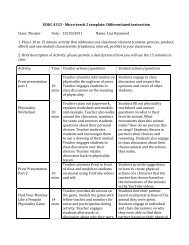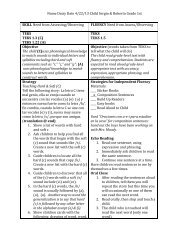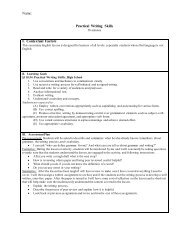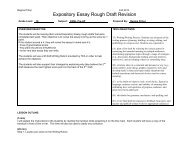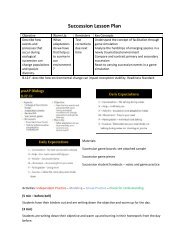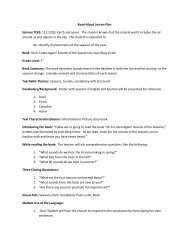Read-Aloud Lesson Plan - St. Edwards University
Read-Aloud Lesson Plan - St. Edwards University
Read-Aloud Lesson Plan - St. Edwards University
You also want an ePaper? Increase the reach of your titles
YUMPU automatically turns print PDFs into web optimized ePapers that Google loves.
Emily KittredgeEmerging Literacy MethodsNovember 16, 2010<strong>Read</strong>-<strong>Aloud</strong> <strong>Lesson</strong> <strong>Plan</strong>: The Color Box by Dayle Ann Dodds(<strong>St</strong>orybook <strong>Read</strong>ing, Lap <strong>Read</strong>ing, <strong>St</strong>ory Time)A Teacher Directed Instructional Method1.Objectivesa. Behavioral objectives: By the conclusion of the lesson the learner will be ableto identify and use words that name actions, directions, positions, sequences, andlocations as well as identify colors.b. Texas Essential Knowledge & Skills (TEKS): §110.11. English Language Artsand <strong>Read</strong>ing, Kindergarten(5) <strong>Read</strong>ing/Vocabulary Development. <strong>St</strong>udents understand new vocabulary and use itcorrectly when reading and writing. <strong>St</strong>udents are expected to:(A) identify and use words that name actions, directions, postitions, sequences,and locations;(C) identify and sort pictures of objects into conceptual categories (e.g. colors,shapes, and textures)2. Purpose & Rationale: Purpose-setting statement: Today’s lesson will give students a chance tounderstand and learn about colors while reading The Color Box by DayleAnn Dodds as well as let them use and apply what they have just learnedto do a fun and useful art activity. Rationale: This lesson will be both entertaining and fun for students whilealso being instructional. It will let students explore colors in a supervisedsetting independently.3. Materialsa. The Color Box by Dayle Ann Dodds, illustrated by Giles LarocheColored markersButcher paperb. Colored markersWhite paperWriting utensils1 copy of The Color Box by Dayle Ann Dodds for each small group of 4students4. Procedures / Activities for a <strong>Read</strong> <strong>Aloud</strong>Before <strong>Read</strong>ingo Discuss colors and have children give examples within theclassroom.o Within The Color Box there is some important vocabulary that thestudents should learn. They all happen to be action words such as:
found, peeked, peered, crawled, climbed, splashed, popped,wiggled, slipped, searched, etc. These words can discussed as aclass and then each student can act out one of the words. This willgive them an understanding of their meanings before reading thebook as well as let them be interactive with each other and words.o Motivation for the reading of The Color Box will be generated witha brief conversation about colors as well as the vocabulary activityexplained above. Asking the students such questions as what theirfavorite colors are or what color shirt they are wearing willgenerate excitement and motivation to listen during the reading ofthe book.During <strong>Read</strong>ing (Orally with lots of expression)o Page: 1-2, Ask: “Does anyone know what kind of animalAlexander is?”o Page 9-10, Ask: “What do you think Alexander is going to find?”o Page 11-12, Ask: “Can anyone tell me or show me something thatis yellow?”o Page 13, Ask: “What are some other things that are orange?”o Page 19-20, Ask: “What are some other things that are blue?”;“What kind of animal is Alexander riding on?”o Page 21-22, Ask: “Besides these things that are red, what are someother examples?”o Page 23-24, Ask: “What else is green?”o Page 25-26, Ask: “Who can tell me something that is purple?”o Page 31-32, Ask: “What do you think Alexander is going to findwhen he opens the door?”o Page 33-34, Ask: “Can anyone tell me some of the colors they seein this picture?”After <strong>Read</strong>ingo Children will be given time to respond to the text.• Encourage students to discuss the text with the teacher. Agroup discussion would be best. The teacher could use alarge piece of butcher paper and make a color chart.<strong>St</strong>udents would raise their hands and recall objects from thestory plus their color.• <strong>St</strong>udents would then make their own color chart at theirdesk using the teachers on the board as an example. All thebasic colors mentioned within the book would be used(black, yellow, orange, blue, red, green, purple, and white).<strong>St</strong>udents would label colors and give a few examples ofreal life objects, animals, etc that are that color.5. <strong>Plan</strong>ned Modifications (GT, ESL, LD, etc.):GT: for higher-level students a modified lesson planwould be for them to make their own 5-6 page bookusing the colors learned in the lesson. Each pagecould correspond to a color and then they could


